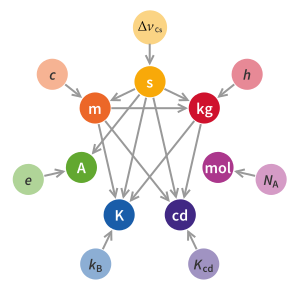This article needs to be updated. The reason given is: Several sections are still written as if the definition is yet to be decided e.g. references to "currently accepted" values since redefined. (December 2023) |
The scientific community examined several approaches to redefining the kilogram before deciding on a revision of the SI in November 2018. Each approach had advantages and disadvantages.
Prior to the redefinition, the kilogram and several other SI units based on the kilogram were defined by an artificial metal object called the international prototype of the kilogram (IPK).[1] There was broad agreement that the older definition of the kilogram should be replaced.

The International Committee for Weights and Measures (CIPM) approved a redefinition of the SI base units in November 2018 that defines the kilogram by defining the Planck constant to be exactly 6.62607015×10−34 kg⋅m2⋅s−1. This approach effectively defines the kilogram in terms of the second and the metre, and took effect on 20 May 2019.[1][2][3][4]
In 1960, the metre, previously similarly having been defined with reference to a single platinum-iridium bar with two marks on it, was redefined in terms of an invariant physical constant (the wavelength of a particular emission of light emitted by krypton,[5] and later the speed of light) so that the standard can be independently reproduced in different laboratories by following a written specification.
At the 94th Meeting of the International Committee for Weights and Measures (CIPM) in 2005, it was recommended that the same be done with the kilogram.[6]
In October 2010, the CIPM voted to submit a resolution for consideration at the General Conference on Weights and Measures (CGPM), to "take note of an intention" that the kilogram be defined in terms of the Planck constant, h (which has dimensions of energy times time) together with other physical constants.[7][8] This resolution was accepted by the 24th conference of the CGPM[9] in October 2011 and further discussed at the 25th conference in 2014.[10][11] Although the Committee recognised that significant progress had been made, they concluded that the data did not yet appear sufficiently robust to adopt the revised definition, and that work should continue to enable the adoption at the 26th meeting, scheduled for 2018.[10] Such a definition would theoretically permit any apparatus that was capable of delineating the kilogram in terms of the Planck constant to be used as long as it possessed sufficient precision, accuracy and stability. The Kibble balance is one way do this.
As part of this project, a variety of very different technologies and approaches were considered and explored over many years. Some of these approaches were based on equipment and procedures that would have enabled the reproducible production of new, kilogram-mass prototypes on demand using measurement techniques and material properties that are ultimately based on, or traceable to, physical constants. Others were based on devices that measured either the acceleration or weight of hand-tuned kilogram test masses and which expressed their magnitudes in electrical terms via special components that permit traceability to physical constants. Such approaches depend on converting a weight measurement to a mass, and therefore require the precise measurement of the strength of gravity in laboratories. All approaches would have precisely fixed one or more constants of nature at a defined value.
- ^ a b Resnick, Brian (20 May 2019). "The new kilogram just debuted. It's a massive achievement". vox.com. Retrieved 23 May 2019.
- ^ Draft Resolution A "On the revision of the International System of units (SI)" to be submitted to the CGPM at its 26th meeting (2018) (PDF), archived from the original (PDF) on 2018-04-29, retrieved 2019-06-26
- ^ Decision CIPM/105-13 (October 2016). The day is the 144th anniversary of the Metre Convention.
- ^ Pallab Ghosh (November 16, 2018). "Kilogram gets a new definition". BBC News. Retrieved November 16, 2018.
- ^ International Bureau of Weights and Measures (2006), The International System of Units (SI) (PDF) (8th ed.), p. 112, ISBN 92-822-2213-6, archived (PDF) from the original on 2021-06-04, retrieved 2021-12-16
- ^ Recommendation 1: Preparative steps towards new definitions of the kilogram, the ampere, the kelvin and the mole in terms of fundamental constants (PDF). 94th meeting of the International Committee for Weights and Measures. October 2005. p. 233. Archived (PDF) from the original on June 30, 2007. Retrieved February 7, 2018.
- ^ "NIST Backs Proposal for a Revamped System of Measurement Units". Nist.gov. 26 October 2010. Retrieved April 3, 2011.
- ^ Ian Mills (September 29, 2010). "Draft Chapter 2 for SI Brochure, following redefinitions of the base units" (PDF). CCU. Retrieved January 1, 2011.
- ^ Resolution 1 – On the possible future revision of the International System of Units, the SI (PDF). 24th meeting of the General Conference on Weights and Measures. Sèvres, France. October 17–21, 2011. Retrieved October 25, 2011.
- ^ a b "BIPM - Resolution 1 of the 25th CGPM". www.bipm.org. Retrieved 2017-03-27.
- ^ "General Conference on Weights and Measures approves possible changes to the International System of Units, including redefinition of the kilogram" (PDF) (Press release). Sèvres, France: General Conference on Weights and Measures. October 23, 2011. Retrieved October 25, 2011.